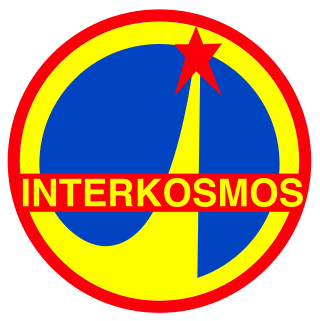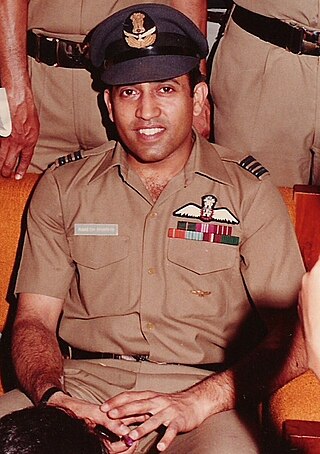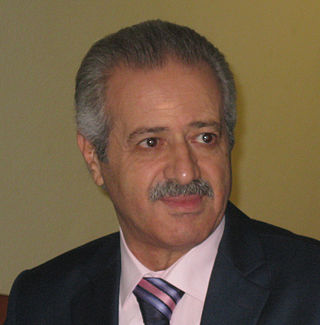
Interkosmos was a Soviet space program, designed to help the Soviet Union's allies with crewed and uncrewed space missions.

Salyut 7 was a space station in low Earth orbit from April 1982 to February 1991. It was first crewed in May 1982 with two crew via Soyuz T-5, and last visited in June 1986, by Soyuz T-15. Various crew and modules were used over its lifetime, including 12 crewed and 15 uncrewed launches in total. Supporting spacecraft included the Soyuz T, Progress, and TKS spacecraft.

Wing Commander Rakesh Sharma, AC is a former Indian Air Force pilot who flew aboard Soyuz T-11 on 3 April 1984 as part of the Soviet Interkosmos programme. He is the only Indian citizen to travel in space, although there have been other astronauts of Indian origin who travelled to space, who were not Indian citizens. Another Air Force pilot, Ravish Malhotra, was placed on standby.

The Indian Air Force (IAF) is the air arm of the Indian Armed Forces. Its primary mission is to secure Indian airspace and to conduct aerial warfare during armed conflicts. It was officially established on 8 October 1932 as an auxiliary air force of the British Empire which honoured India's aviation service during World War II with the prefix Royal. After India gained independence from United Kingdom in 1947, the name Royal Indian Air Force was kept and served in the name of the Dominion of India. With the transition to a republic in 1950, the prefix Royal was removed.

Soyuz 28 was a March 1978 Soviet crewed mission to the orbiting Salyut 6 space station. It was the fourth mission to the station, the third successful docking, and the second visit to the resident crew launched in Soyuz 26.
Abdul Ahad Momand is an Afghan-German and former Afghan Air Force aviator who became the first, and currently only, Afghan citizen to journey to outer space. When he spoke to his mother on the phone from space, Pashto became the fourth language to be officially spoken in space.
Nehru Planetariums are the five planetariums in India, named after India's first Prime Minister, Jawaharlal Nehru. These are located in Mumbai, New Delhi, Pune and Bangalore, plus there is a Jawahar Planetarium in Prayagraj, where Nehru was born.

Arnaldo Tamayo Méndez is a Cuban military officer, legislator, and former cosmonaut and the first person of African heritage in space. In 1980, as a member of the crew of Soyuz 38, he became the first Cuban citizen, the first Latin American, the first person of African descent, and the first person from a country in the Western Hemisphere other than the United States to travel into Earth orbit.
Soyuz 35 was a 1980 Soviet crewed space flight to the Salyut 6 space station. It was the 10th mission to and eighth successful docking at the orbiting facility. The Soyuz 35 crew were the fourth long-duration crew to man the space station.

Soyuz T-2 was a 1980 Soviet crewed space flight to the Salyut 6 space station. It was the 12th mission to and 10th successful docking at the orbiting facility. The Soyuz T-2 crew were the second to visit the long-duration Soyuz 35 resident crew.

Soyuz T-11 was the sixth expedition to the Soviet Salyut 7 space station, which in 1984 carried the first Indian cosmonaut along with Soviet crew members.

Muhammed Ahmed Faris is a Syrian military aviator. He was the first Syrian and the second Arab in space.

Dumitru Dediu was a pilot in the Romanian Air Force and cosmonaut candidate that was assigned as the backup for Dumitru Prunariu.
The Bulgarian cosmonaut program refers to human spaceflight efforts by the People's Republic of Bulgaria. The idea of a Bulgarian crewed space mission predated the launch of Sputnik 1, the first artificial satellite. An informal proposal for the Soviet Union to send a Bulgarian cosmonaut in space was issued in 1964, but it was not seriously considered by the Soviets. Official space cooperation began in 1966 with the establishment of the Interkosmos programme which allowed Communist Bloc countries to access Soviet space technology and assets.

Gaganyaan is an Indian crewed orbital spacecraft intended to be the formative spacecraft of the Indian Human Spaceflight Programme. The spacecraft is being designed to carry three people, and a planned upgraded version will be equipped with rendezvous and docking capabilities. In its maiden crewed mission, the Indian Space Research Organisation (ISRO)'s largely autonomous 5.3-metric ton capsule will orbit the Earth at 400 km altitude for up to seven days with a two- or three-person crew on board. The first crewed mission was originally planned to be launched on ISRO's LVM3 rocket in December 2021. As of October 2023, it is expected to be launched by 2025.

St Thomas' School is a co-educational kindergarten to higher secondary school in Kidderpore, Kolkata, West Bengal, India. It was established on 21 December 1789, making it one of the oldest schools in India and has the largest campus in Kolkata. The school is affiliated to the Council for the Indian School Certificate Examinations (ISC), which conducts the ICSE and ISC examinations over the country.
Thekkethil Kochandy Alex is an Indian space scientist. He was the director of the ISRO Satellite Centre (ISAC) of Indian Space Research Organisation (ISRO) (2008–2012) and Member, Space Commission. He specialized in electro-optic systems and satellite technology. Starting with the first Indian satellite Aryabhata, he has been responsible for the sensor systems in all the Indian satellites. Under his leadership the Laboratory for Electro Optics Systems (LEOS) was established in 1993 and from the inception he was its director till 2008. He was conferred "Dr. Vikram Sarabhai Distinguished Professorship" in 2011.

Jean-Loup Jacques Marie Chrétien is a French retired Général de Brigade in the Armée de l'Air, and a former CNES spationaut. He flew on two Franco-Soviet space missions and a NASA Space Shuttle mission. Chrétien was the first Frenchman and the first western European in space.

The Indian Air Force Test Pilot School is a unit of the Indian Air Force (IAF) that evaluates aircraft and systems for induction into user organisations. Most new aircraft types and major airborne systems must have ASTE's stamp of approval to be considered fit for service in India. While many countries have testing facilities of one kind or the other, training of flight test personnel is not often imparted in them. ASTE's Air Force Test Pilots School (AFTPS) is only the fifth such institution in the world.

















